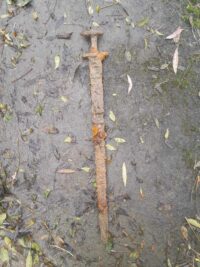 First of all, there is such a thing as a magnet fisherman: ie, someone who uses a powerful neodymium magnet on a rope to retrieve metal objects from bodies of water. I did not know this. Secondly, magnet fisherman Trevor Penny pulled up an intact Viking sword from the River Cherwell in West Oxfordshire last November.
First of all, there is such a thing as a magnet fisherman: ie, someone who uses a powerful neodymium magnet on a rope to retrieve metal objects from bodies of water. I did not know this. Secondly, magnet fisherman Trevor Penny pulled up an intact Viking sword from the River Cherwell in West Oxfordshire last November.
Magnet fishing usually pulls up relatively modern debris — tire rims, keys, bicycles, unexploded ordnance — not iron swords hundreds of years old. Penny didn’t know what it was at first, but after consulting with friends and knowledgeable acquaintances, he called it in to the Portable Antiquities Scheme finds liaison officer in Standlake. The finds liaison officer identified it as a Viking sword dating to between 850 and 975 A.D. It is the oldest object ever discovered in Oxfordshire by magnet fishing.
 It looks like a Petersen Type M to my untutored eye, based on the hilt shaped like a capital I, the long blade and the date range. Type M swords in good condition can retain traces of organic remains (wood, leather, cloth) on the grip, so it’s important that this sword be carefully conserved. It is corroded, but there could be organic treasure hiding underneath that crusty exterior. Thankfully, the sword is already in the hands of museum professionals and will remain there.
It looks like a Petersen Type M to my untutored eye, based on the hilt shaped like a capital I, the long blade and the date range. Type M swords in good condition can retain traces of organic remains (wood, leather, cloth) on the grip, so it’s important that this sword be carefully conserved. It is corroded, but there could be organic treasure hiding underneath that crusty exterior. Thankfully, the sword is already in the hands of museum professionals and will remain there.
Mr Penny confirmed that it will be retained by Oxford museum services and will either stay in Witney or be put on display in a museum.
He added: “There was a little dispute with the landowner and the rivers trust who don’t permit magnet fishing. The latter sent a legal document saying they wouldn’t take action on the condition the sword was passed to a museum, which I had done.”
Myself, I was indeed aware of powerful neodymium magnets on ropes, in order to retrieve (ancient) metal objects from bodies of water.
However, my untutored eye had frankly no idea about a “Petersen Type M” 😉️
There is the ‘Oakeshott typology’, apparently oriented on the Petersen one (still no idea about “R. 489”). – Indeed, mainly stolen bicycles, more or less exploded ordnance and “E-Scooters” over here ⚔️
—–
“The type M (also known as R. 489) describes a sword variant standing between types F and Q. It is characterized by a simple hilt in the shape of the letter I. Sharply cut cross-guard and upper guard are usually straight and of similar height. From the front view, both the upper and cross-guard are of rectangle shape, with the cross-guard slightly bent in rare cases. The upper guard is of simple shape similar to cross-guard, and the tang is held in place by hammering it into a rivet shape; the upper guard is never ended by a pommel. Sides of the guards are usually straight, less often rounded. An important feature of type M swords is undecorated hilt. Blades are usually double-edged (single-edged variants make up to 15% of finds according to Petersen) and simple, although we also know of some Norse and Swedish blades made of pattern welded steel (Androshchuk 2014: 386–7; Petersen 1919: 118). Petersen notes that none of Norse blades carries an inscription, which according to our information is still actual. That said, there is a variant of ULFBERHT inscription on a blade from Eura, Finland (Kazakevičius 1996: 39). While the swords are of simple design, they are made of quality materials.
Type M swords are in general up to one meter long, usually between 80 and 90 cm. The longest sword that we know of is 95 cm long. An average width of Scandinavian blades is 5,5-6 cm, sometimes up to 6,5 cm. (…) In order to outline anatomy of this interesting type, we chose six relatively well-preserved swords that we will describe in more detail. … (Tomáš Vlasatý, 8. June 2019, “Petersen type M sword”)
—–
I always feel grateful when I read about honest people turning over their finds to the proper experts.
History is too important for all of us to have treasures like this end up on the black market.
🥰
So it will end up in some drawer in a museums collection or in the private collection of one of the museum officials, who almost always have the best private collections. Why should the state be able to take it from the finder? What makes it the property of the state? They are neither the original owners nor the finders.
What rubbish you talk, it will be examined and then displayed in a museum, it might not be displayed forever as other objects are displayed or are found, and as for your insinuation that it will be in the museums officials private collection is liable. The state is us so yes we do own it and if deemed important will be kept by us for everyone to see.
This knee-jerk reaction that private owners are despicable is founded on the assumption that black markets destroy all provenance and hide treasures from the public.
It’s about as intelligent as saying that marijuana is dangerous because buying and selling and using involves black markets.
In both cases, the markets are reprehensible only because they are illegal. As for antiquities, stop making private ownership illegal and the provenance will be valuable again.
There’s something hypocritical about saying black market antiquities buyers are greedy for profit, yet denying that including the provenance of legal antiquities would enhance that value. You can’t have it both ways. Either they are greedy and want to spend enormous gobs of money to hide something from even their friends to avoid the police finding out, in which case they’d be even happier to establish legal provenance and increase the value; or they don’t give a fig about the value and won’t spend a dime acquiring illegal antiquities.
This sword is an important find and only adds to the information we know from the vikings in England. Trevor Penny did the correct thing in handing it in so we can learn from this magnificent find, however, if the sword isn’t treated and preserved correctly it would just crumble away to nothing in time. Having said that, I hope people like Mr Penny are rewarded for his honesty which will only encourage other people to hand in their finds so a record can be kept which is so important in our history.
Amen to that, I sure hope the Museum paid Mr. Penny what the sword was worth.
Ah, you can see the honest and dishonest people here. Dishonest people are notable for the blather they come out with just because they cannot legally go on someone else’s land and steal whatever they find there.
I mean, if I went around there shed and took whatever I found there, they would be the first to complain.
“–They cannot legally go on someone else’s land and steal whatever they find there.”
From a *VIKING* point of view, that’s a ‘NAVIGABLE SOLUTION’, actually 🤠️
———
PS: “Abul-Abbas” was the elephant brought over the Alps to Charlemagne as a gift from the caliph Harun al-Rashid. Unfortunately, the elephant died in 810AD on a campaign against the Vikings/ Danes at a place called Lippeham.
In the 18th century, however, elephant bones –that apparently were found near the mouth of river Lippe – seem to have ended up in a private collection, never to be seen again:
The Royal Frankish Annals note for 810AD:
“Imperator vero Aquisgrani adhuc agens et contra Godofridum regem […], deinde transmisso Rheno flumine in loco, qui Lippeham vocatur, […] elefans ille, quem ei Aaron rex Sarracenorum miserat, subita morte periit.”
One of the photos in the link shows a bayonet, not a sword.
Sorry, the photo was changed